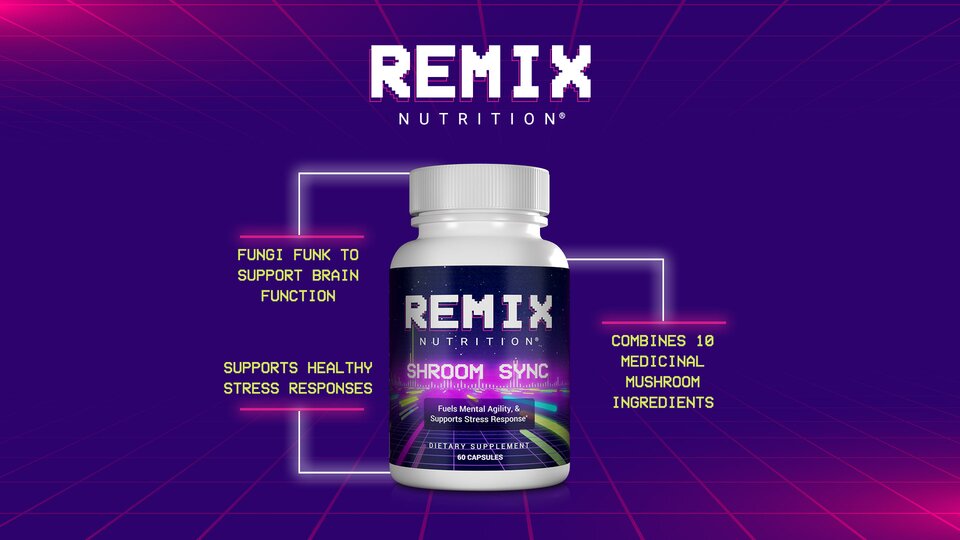Shroom Sync provides you with the benefits of 10 different types of medicinal mushrooms to help improve your overall health. Mushrooms can provide you with proteins, fats, essential amino acids, volatile oils, carotenoids, phenolic compounds, flavonoids, minerals (Fe, Ca, Mg, Ni, Sr, Na, Ti, Pi, Se, Mn, Zn, Al, Si, K, Cr, Ga, V and Zr), vitamins (B1, B2, B12, E and K) (1). This blend includes 266 mg of Cordyceps Sinensis, Reishi, Shiitake, and Lions Mane plus another 266 mg of a blend of six other mushrooms including Maitake, Turkey Tail, Chaga, Royal Sun Agaricus, White Button, and Black Fungus.
Cordyceps sinensis (CS) is a well-known fungus, naturally distributed in the Tibetan Plateau of the Himalayas and used in traditional Chinese medicine (TCM) because of its various potential therapeutic qualities for being adaptogenic, neuroprotective, nootropic, anti-inflammatory, anti-oxidative, immune-regulating, and anti-fatigue (2). Cordyceps contain many beneficial components such as cordycepin, γ-aminobutyric acid (GABA), high levels of amino acids like l-arginine, Ergothioneine, phenolic acids and flavonoids (3)(4). Cordycepin (or 3’-deoxyadenosine) is a novel bio-metabolite that has potent anti-oxidant and inflammation-supporting effects (5)(6). Cordycepin could be a potentially game-changing workout supplement because it is an indirect precursor of ATP similar to creatine and boosts nitric oxide (NO) to enhance blood flow and performance (6)(7)(8).
Reishi Mushrooms or lingzhi or ganoderma lucidum have been used extensively in Eastern medicine for the past 2000 years to enhance energy, maintain blood glucose levels, boost the immune system, and have pharmacological potential for diabetes, inflammation, epilepsy, neurodegeneration, cancer, anxiety, sedation, cardiac diseases, depression, hepatic diseases, and immune disorders (9)(10). The three main physiologically active constituents are polysaccharides, peptidoglycans, and triterpenes which account for the broad range of reported bioactivities, including anti-inflammatory, hypoglycemic, antiulcer, antitumorigenic, and immunostimulating effects (9). In a randomized, double-blind and placebo-controlled study, researchers determined that reishi mushroom extract may combat the symptoms of fatigue, irritability, headache, and lassitude (11).
Shiitake or lentinus edodes is a culinary and medicinal mushroom rich in protein, fiber, minerals, vitamins, antioxidant compounds, and β-glucans which may have potent antioxidant, inflammation-supporting and regenerative properties due to the presence of many bioactive compounds such as ergothioneine. (12)(13). In a randomized, double-blind, placebo-controlled study found that shiitake may improve triglyceride levels, total cholesterol, low-density lipoprotein, glucose, and oxidative stress (13). A 4-week human trial found that a daily shiitake mushroom supplement enhanced cell function, improved gut immunity, and mitigated inflammation (14).
Lion’s mane, scientifically known as hericium erinaceus, is a culinary and medicinal mushroom with potential neuroprotective and antioxidant properties for brain health. Lion’s mane has gained recent popularity because a double-blind placebo human study of mild Alzheimer patients demonstrated a potential improvement in activities of daily living with better biomarkers while taking a daily lion’s mane supplement (15). In other scientifically rigorous human trials, confirmed that lion’s mane mushrooms helped individuals improve their cognition scores on various tests (16)(17).
Hen-of-the-woods or Maitake or grifola frondosa is a Japanese mushroom characterized by overlapping caps. It is increasingly being recognized as a potent source of bioactive proteins and peptides, polysaccharide, and β-glucans with dramatic health-promoting potential (18). The main benefits of these maitake mushrooms are the enhancement of immune-related cells such as cytotoxic T-cells and natural killer (NK) cells, promoting gut microbiota, and combating the symptoms of diabetes, lipid metabolism, and hypertension (19).
Chaga mushroom, scientifically known as inonotus obliquus, is a hardened, irregularly shaped fungus that grows primarily on birch trees (20). It has been used in eastern alternative medicine for centuries to help with inflammation support, immune support, gut health, and mental focus (21). While western scientific research is starting to show that chaga has a wide variety of potentially beneficial compounds such as polyphenols, melanin, triterpenoids, and polysaccharides.
Sun mushrooms or Himematsutake or agaricus blazei are traditionally used in Brazil and Japanese to treat various ailments (22)(23). The scientific literature suggests that these mushrooms have nutritional and therapeutic uses, but more research still needs to be performed (24). Agaricus blazei contain phenolics, β-glucans, and lipophilic compounds that support claims of antioxidant, anti-inflammatory and immunomodulatory effects (24)(25). In an animal study, agaricus blazei extract promoted positive immunomodulation by enhancing levels of interleukein-6 and interferon-gamma (26).
Turkey Tail or trametes versicolor is a mushroom used in traditional Chinese medicine for 2000 years for its ability to enhance endurance and longevity (27). It has high levels of protein, fat, phenolic compounds, polysaccharides, flavonoids, essential and nonessential amino acids that could explain its immune-activating bioactivity (28) (29). Most importantly, turkey tail mushrooms contain polysaccharide K which has shown promise in supporting immune function in some animal and human studies (27)(30)(31).
References:
- https://www.ncbi.nlm.nih.gov/pmc/articles/PMC7356751/
- https://pubmed.ncbi.nlm.nih.gov/32288795/
- https://pubmed.ncbi.nlm.nih.gov/24941169/
- https://www.ncbi.nlm.nih.gov/pmc/articles/PMC8622900/
- https://pubmed.ncbi.nlm.nih.gov/32545666/
- https://pubmed.ncbi.nlm.nih.gov/28324458/
- https://www.ncbi.nlm.nih.gov/pmc/articles/PMC8622900/#B64-foods-10-02634
- https://www.ncbi.nlm.nih.gov/pmc/articles/PMC6632035/
- https://www.ncbi.nlm.nih.gov/books/NBK92757/
- https://pubmed.ncbi.nlm.nih.gov/34411377/
- https://pubmed.ncbi.nlm.nih.gov/15857210/
- https://pubmed.ncbi.nlm.nih.gov/23756400/
- https://pubmed.ncbi.nlm.nih.gov/34375514/
- https://pubmed.ncbi.nlm.nih.gov/25866155/
- https://pubmed.ncbi.nlm.nih.gov/32581767/
- https://pubmed.ncbi.nlm.nih.gov/18844328/
- https://pubmed.ncbi.nlm.nih.gov/31413233/
- https://pubmed.ncbi.nlm.nih.gov/11207456/
- https://www.ncbi.nlm.nih.gov/pmc/articles/PMC7824844/
- https://www.ncbi.nlm.nih.gov/pmc/articles/PMC8124789/
- https://pubmed.ncbi.nlm.nih.gov/22942760/
- https://pubmed.ncbi.nlm.nih.gov/18317543/
- https://www.ncbi.nlm.nih.gov/pmc/articles/PMC2249742/
- https://pubmed.ncbi.nlm.nih.gov/28103773/
- https://pubmed.ncbi.nlm.nih.gov/21912538/
- https://pubmed.ncbi.nlm.nih.gov/19779112/
- https://www.ncbi.nlm.nih.gov/pmc/articles/PMC7277906/
- https://pubmed.ncbi.nlm.nih.gov/31791317/
- https://pubmed.ncbi.nlm.nih.gov/32865897/
- https://pubmed.ncbi.nlm.nih.gov/1702689/
- https://pubmed.ncbi.nlm.nih.gov/15908782/

I learned a lot from this article. Keep up the great work!